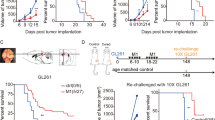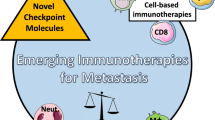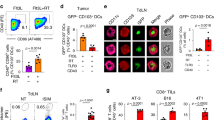Abstract
Checkpoint blockade with antibodies specific for cytotoxic T lymphocyte–associated protein (CTLA)-4 or programmed cell death 1 (PDCD1; also known as PD-1) elicits durable tumor regression in metastatic cancer, but these dramatic responses are confined to a minority of patients. This suboptimal outcome is probably due in part to the complex network of immunosuppressive pathways present in advanced tumors, which are unlikely to be overcome by intervention at a single signaling checkpoint. Here we describe a combination immunotherapy that recruits a variety of innate and adaptive immune cells to eliminate large tumor burdens in syngeneic tumor models and a genetically engineered mouse model of melanoma; to our knowledge tumors of this size have not previously been curable by treatments relying on endogenous immunity. Maximal antitumor efficacy required four components: a tumor-antigen-targeting antibody, a recombinant interleukin-2 with an extended half-life, anti-PD-1 and a powerful T cell vaccine. Depletion experiments revealed that CD8+ T cells, cross-presenting dendritic cells and several other innate immune cell subsets were required for tumor regression. Effective treatment induced infiltration of immune cells and production of inflammatory cytokines in the tumor, enhanced antibody-mediated tumor antigen uptake and promoted antigen spreading. These results demonstrate the capacity of an elicited endogenous immune response to destroy large, established tumors and elucidate essential characteristics of combination immunotherapies that are capable of curing a majority of tumors in experimental settings typically viewed as intractable.
This is a preview of subscription content, access via your institution
Access options
Subscribe to this journal
Receive 12 print issues and online access
$209.00 per year
only $17.42 per issue
Buy this article
- Purchase on Springer Link
- Instant access to full article PDF
Prices may be subject to local taxes which are calculated during checkout






Similar content being viewed by others
References
Hodi, F.S. et al. Improved survival with ipilimumab in patients with metastatic melanoma. N. Engl. J. Med. 363, 711–723 (2010).
Topalian, S.L. et al. Safety, activity and immune correlates of anti-PD-1 antibody in cancer. N. Engl. J. Med. 366, 2443–2454 (2012).
Larkin, J. et al. Combined nivolumab and ipilimumab or monotherapy in untreated melanoma. N. Engl. J. Med. 373, 23–34 (2015).
Gajewski, T.F. The next hurdle in cancer immunotherapy: overcoming the non-T-cell-inflamed tumor microenvironment. Semin. Oncol. 42, 663–671 (2015).
Zou, W., Wolchok, J.D. & Chen, L. PD-L1 (B7-H1) and PD-1 pathway blockade for cancer therapy: mechanisms, response biomarkers and combinations. Sci. Transl. Med. 8, 328rv4 (2016).
Mellman, I., Coukos, G. & Dranoff, G. Cancer immunotherapy comes of age. Nature 480, 480–489 (2011).
Drake, C.G. Combination immunotherapy approaches. Ann. Oncol. 23 (Suppl. 8), 41–46 (2012).
Sharma, P. & Allison, J.P. The future of immune checkpoint therapy. Science 348, 56–61 (2015).
Smyth, M.J., Ngiow, S.F., Ribas, A. & Teng, M.W.L. Combination cancer immunotherapies tailored to the tumor microenvironment. Nat. Rev. Clin. Oncol. 13, 143–158 (2016).
Curran, M.A., Kim, M., Montalvo, W., Al-Shamkhani, A. & Allison, J.P. Combination CTLA-4 blockade and 4-1BB activation enhances tumor rejection by increasing T cell infiltration, proliferation and cytokine production. PLoS One 6, e19499 (2011).
Carmi, Y. et al. Allogeneic IgG combined with dendritic cell stimuli induce antitumor T cell immunity. Nature 521, 99–104 (2015).
Hu-Lieskovan, S. et al. Improved antitumor activity of immunotherapy with BRAF and MEK inhibitors in BRAFV600E melanoma. Sci. Transl. Med. 7, 279ra41 (2015).
Rapoport, A.P. et al. Combination immunotherapy after ASCT for multiple myeloma using MAGE-A3–poly-ICLC immunizations followed by adoptive transfer of vaccine-primed and co-stimulated autologous T cells. Clin. Cancer Res. 20, 1355–1365 (2014).
Lum, L.G. et al. Targeted T cell therapy in stage IV breast cancer: a phase 1 clinical trial. Clin. Cancer Res. 21, 2305–2314 (2015).
Ribas, A. et al. Phase 1 study combining anti-PD-L1 (MEDI4736) with BRAF (dabrafenib) and/or MEK (trametinib) inhibitors in advanced melanoma. ASCO Annual Meeting Proceedings 33, abstract 3003 (American Society of Clinical Oncology, Alexandria, Virginia, USA, 2015).
Chen, G. et al. A feasibility study of cyclophosphamide, trastuzumab and an allogeneic GM-CSF-secreting breast tumor vaccine for HER2+ metastatic breast cancer. Cancer Immunol. Res. 2, 949–961 (2014).
Overwijk, W.W. et al. Tumor regression and autoimmunity after reversal of a functionally tolerant state of self-reactive CD8+ T cells. J. Exp. Med. 198, 569–580 (2003).
Klebanoff, C.A. et al. Determinants of successful CD8+ T cell adoptive immunotherapy for large established tumors in mice. Clin. Cancer Res. 17, 5343–5352 (2011).
DuPage, M. et al. Endogenous T cell responses to antigens expressed in lung adenocarcinomas delay malignant tumor progression. Cancer Cell 19, 72–85 (2011).
Stromnes, I.M. et al. T cells engineered against a native antigen can surmount immunologic and physical barriers to treat pancreatic ductal adenocarcinoma. Cancer Cell 28, 638–652 (2015).
Zhu, E.F. et al. Synergistic innate and adaptive immune response to combination immunotherapy with anti-tumor-antigen antibodies and extended serum half-life IL-2. Cancer Cell 27, 489–501 (2015).
Liu, H. et al. Structure-based programming of lymph node targeting in molecular vaccines. Nature 507, 519–522 (2014).
Moore, S.J. et al. Engineered knottin peptide enables non-invasive optical imaging of intracranial medulloblastoma. Proc. Natl. Acad. Sci. USA 110, 14598–14603 (2013).
Phan, G.Q., Attia, P., Steinberg, S.M., White, D.E. & Rosenberg, S.A. Factors associated with response to high-dose interleukin-2 in patients with metastatic melanoma. J. Clin. Oncol. 19, 3477–3482 (2001).
Rose, S., Misharin, A. & Perlman, H. A novel Ly6C- and Ly6G-based strategy to analyze the mouse splenic myeloid compartment. Cytometry A 81, 343–350 (2012).
Ostrand-Rosenberg, S. & Sinha, P. Myeloid-derived suppressor cells: linking inflammation and cancer. J. Immunol. 182, 4499–4506 (2009).
Hildner, K. et al. Batf3 deficiency reveals a critical role for CD8-α+ dendritic cells in cytotoxic T cell immunity. Science 322, 1097–1100 (2008).
Rafiq, K., Bergtold, A. & Clynes, R. Immune-complex-mediated antigen presentation induces tumor immunity. J. Clin. Invest. 110, 71–79 (2002).
Broz, M.L. et al. Dissecting the tumor myeloid compartment reveals rare activating antigen-presenting cells critical for T cell immunity. Cancer Cell 26, 638–652 (2014).
Roberts, E.W. et al. Critical role for CD103+/CD141+ dendritic cells bearing CCR7 for tumor antigen trafficking and priming of T cell immunity in melanoma. Cancer Cell 30, 324–336 (2016).
Salmon, H. et al. Expansion and activation of CD103+ dendritic cell progenitors at the tumor site enhances tumor responses to therapeutic PD-L1 and BRAF inhibition. Immunity 44, 924–938 (2016).
Dankort, D. et al. BrafV600E cooperates with Pten loss to induce metastatic melanoma. Nat. Genet. 41, 544–552 (2009).
Mendiratta, S.K. et al. Therapeutic tumor immunity induced by polyimmunization with melanoma antigens gp100 and TRP-2. Cancer Res. 61, 859–863 (2001).
Nelson, M.H. et al. Toll-like receptor agonist therapy can profoundly augment the antitumor activity of adoptively transferred CD8+ T cells without host preconditioning. J. Immunother. Cancer 4, 6 (2016).
Woo, S.R., Corrales, L. & Gajewski, T.F. Innate immune recognition of cancer. Annu. Rev. Immunol. 33, 445–474 (2015).
van Egmond, M. & Bakema, J.E. Neutrophils as effector cells for antibody-based immunotherapy of cancer. Semin. Cancer Biol. 23, 190–199 (2013).
Weiskopf, K. & Weissman, I.L. Macrophages are critical effectors of antibody therapies for cancer. MAbs 7, 303–310 (2015).
DiLillo, D.J. & Ravetch, J.V. Differential Fc receptor engagement drives an antitumor vaccinal effect. Cell 161, 1035–1045 (2015).
van Montfoort, N. et al. Antigen storage compartments in mature dendritic cells facilitate prolonged cytotoxic T lymphocyte cross-priming capacity. Proc. Natl. Acad. Sci. USA 106, 6730–6735 (2009).
Guilliams, M., Bruhns, P., Saeys, Y., Hammad, H. & Lambrecht, B.N. The function of Fc-γ receptors in dendritic cells and macrophages. Nat. Rev. Immunol. 14, 94–108 (2014).
Clatworthy, M.R. et al. Immune complexes stimulate CCR7-dependent dendritic cell migration to lymph nodes. Nat. Med. 20, 1458–1463 (2014).
Albanesi, M. et al. Neutrophils mediate antibody-induced antitumor effects in mice. Blood 122, 3160–3164 (2013).
Allan, R.S. et al. Migratory dendritic cells transfer antigen to a lymph-node-resident dendritic cell population for efficient CTL priming. Immunity 25, 153–162 (2006).
den Haan, J.M., Lehar, S.M. & Bevan, M.J. CD8+ but not CD8− dendritic cells cross-prime cytotoxic T cells in vivo. J. Exp. Med. 192, 1685–1696 (2000).
Gasteiger, G. et al. IL-2-dependent tuning of NK cell sensitivity for target cells is controlled by regulatory T cells. J. Exp. Med. 210, 1167–1178 (2013).
List, J. et al. Cytokine responses to intraventricular injection of interleukin-2 into patients with leptomeningeal carcinomatosis: rapid induction of tumor necrosis factor–α, interleukin 1–β, interleukin-6, γ-interferon and soluble interleukin-2 receptor (Mr 55,000 protein). Cancer Res. 52, 1123–1128 (1992).
Carreno, B.M. et al. Cancer immunotherapy. A dendritic cell vaccine increases the breadth and diversity of melanoma neoantigen-specific T cells. Science 348, 803–808 (2015).
DuPage, M., Mazumdar, C., Schmidt, L.M., Cheung, A.F. & Jacks, T. Expression of tumor-specific antigens underlies cancer immuno-editing. Nature 482, 405–409 (2012).
Vigneron, N., Stroobant, V., Van den Eynde, B.J. & van der Bruggen, P. Database of T cell–defined human tumor antigens: the 2013 update. Cancer Immun. 13, 15 (2013).
Yadav, M. et al. Predicting immunogenic tumor mutations by combining mass spectrometry and exome sequencing. Nature 515, 572–576 (2014).
Gubin, M.M. et al. Checkpoint blockade cancer immunotherapy targets tumor-specific mutant antigens. Nature 515, 577–581 (2014).
Desgrosellier, J.S. & Cheresh, D.A. Integrins in cancer: biological implications and therapeutic opportunities. Nat. Rev. Cancer 10, 9–22 (2010).
Morgan, R.A. et al. Cancer regression in patients after transfer of genetically engineered lymphocytes. Science 314, 126–129 (2006).
Johnson, L.A. et al. Gene therapy with human and mouse T cell receptors mediates cancer regression and targets normal tissues expressing cognate antigen. Blood 114, 535–546 (2009).
Tzeng, A., Kwan, B.H., Opel, C.F., Navaratna, T. & Wittrup, K.D. Antigen specificity can be irrelevant to immunocytokine efficacy and biodistribution. Proc. Natl. Acad. Sci. USA 112, 3320–3325 (2015).
Boggio, K. et al. Interleukin-12-mediated prevention of spontaneous mammary adenocarcinomas in two lines of Her-2/neu transgenic mice. J. Exp. Med. 188, 589–596 (1998).
Guevara-Patiño, J.A. et al. Optimization of a self-antigen for presentation of multiple epitopes in cancer immunity. J. Clin. Invest. 116, 1382–1390 (2006).
van Stipdonk, M.J.B. et al. Design of agonistic altered peptides for the robust induction of CTL directed towards H-2Db in complex with the melanoma-associated epitope gp100. Cancer Res. 69, 7784–7792 (2009).
Malakhov, M.P. et al. SUMO fusions and SUMO-specific protease for efficient expression and purification of proteins. J. Struct. Funct. Genomics 5, 75–86 (2004).
Rubinstein, M.P. et al. Converting IL-15 to a superagonist by binding to soluble IL-15Rα. Proc. Natl. Acad. Sci. USA 103, 9166–9171 (2006).
Hooijkaas, A.I., Gadiot, J., van der Valk, M., Mooi, W.J. & Blank, C.U. Targeting BRAFV600E in an inducible murine model of melanoma. Am. J. Pathol. 181, 785–794 (2012).
Muzumdar, M.D., Tasic, B., Miyamichi, K., Li, L. & Luo, L. A global double-fluorescent Cre reporter mouse. Genesis 45, 593–605 (2007).
Chen, B. et al. Dynamic imaging of genomic loci in living human cells by an optimized CRISPR–Cas system. Cell 155, 1479–1491 (2013).
Joshi, N.S. et al. Regulatory T cells in tumor-associated tertiary lymphoid structures suppress antitumor T cell responses. Immunity 43, 579–590 (2015).
Acknowledgements
This work was supported in part by the Koch Institute Support (core) grant P30-CA14051 from the National Cancer Institute, the US National Institutes of Health (NIH) grant CA174795 (K.D.W.), the Bridge Project partnership between the Koch Institute for Integrative Cancer Research and the Dana Farber–Harvard Cancer Center (DF–HCC) (D.J.I.), the V Foundation (D.J.I.) and the Ragon Institute (D.J.I.). K.D.M. and J.M.E. are supported by the Fannie and John Hertz Foundation Fellowship; K.D.M., C.F.O., J.M.E., B.H.K. and E.F.Z. are supported by NSF Graduate Research Fellowships; A.M.R. is supported by the NIGMS–NIH Interdepartmental Biotechnology Training Program (NIH #T32GM008334); A.T. is supported by the Siebel Scholarship; and G.L.S. was supported by the NIH with a Ruth L. Kirschstein National Research Service Award (CA180586). We thank T.C. Wu (Johns Hopkins University) for kindly providing the TC-1 tumor cells, D. Sabatini (Whitehead Institute) for providing the Cas9 constructs and G. Dranoff (Dana-Farber Cancer Institute) for providing the DD-Her2/neu and B16-OVA cells. We thank M. Ghebremichael (Ragon Institute of MGH, MIT and Harvard) for helpful statistical advice. We thank the Koch Institute Swanson Biotechnology Center for technical support, specifically the applied therapeutics and whole-animal imaging core facility, the histology and the flow cytometry core facilities. D.J.I. is an investigator of the Howard Hughes Medical Institute.
Author information
Authors and Affiliations
Contributions
K.D.M., C.F.O., D.J.I. and K.D.W. designed the studies and wrote the manuscript; K.D.M. and C.F.O. carried out experiments; E.F.Z., A.T., B.H.K., M.J.K. and H.S. assisted with protein production; J.M.E. assisted in generating the Trp2-knockout line using CRISPR–Cas9; K.R., A.T., E.F.Z., W.A., R.T.W., A.M.R., R.L.K., N.K.M. and K.H. assisted with experiments; G.L.S. designed and analyzed intratumoral Luminex, and assisted in flow cytometry design and writing of the manuscript; D.A.L. aided with multivariate analysis of intratumoral Luminex data; G.L.S. and M.H.Z. conducted intratumoral Luminex and assisted with Braf/Pten mouse experiments; S.K. assisted with immunofluorescence microscopy; and J.R.C. supplied 2.5F–Fc reagents.
Corresponding authors
Ethics declarations
Competing interests
D.J.I. holds equity in Vedantra Pharmaceuticals, which holds a license to the amphiphile–vaccine technology used in these studies.
Supplementary information
Supplementary Text and Figures
Supplementary Figures 1–9, Supplementary Tables 1 and 2 (PDF 28714 kb)
Rights and permissions
About this article
Cite this article
Moynihan, K., Opel, C., Szeto, G. et al. Eradication of large established tumors in mice by combination immunotherapy that engages innate and adaptive immune responses. Nat Med 22, 1402–1410 (2016). https://doi.org/10.1038/nm.4200
Received:
Accepted:
Published:
Issue Date:
DOI: https://doi.org/10.1038/nm.4200
This article is cited by
-
Inhalable extracellular vesicle delivery of IL-12 mRNA to treat lung cancer and promote systemic immunity
Nature Nanotechnology (2024)
-
CAR-T cell therapy targeting surface expression of TYRP1 to treat cutaneous and rare melanoma subtypes
Nature Communications (2024)
-
Targeting myeloperoxidase limits myeloid cell immunosuppression enhancing immune checkpoint therapy for pancreatic cancer
Cancer Immunology, Immunotherapy (2024)
-
CD16 CAR-T cells enhance antitumor activity of CpG ODN-loaded nanoparticle-adjuvanted tumor antigen-derived vaccinevia ADCC approach
Journal of Nanobiotechnology (2023)
-
Cooperative phagocytosis of solid tumours by macrophages triggers durable anti-tumour responses
Nature Biomedical Engineering (2023)



